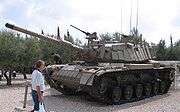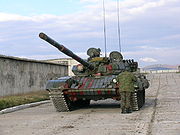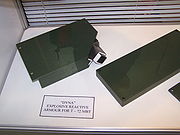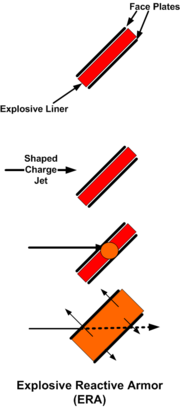
Reactive armour
Encyclopedia


Vehicle armour
Military vehicles are commonly armoured to withstand the impact of shrapnel, bullets, missiles, or shells, protecting the personnel inside from enemy fire. Such vehicles include tanks, aircraft, and ships....
that reacts in some way to the impact of a weapon to reduce the damage done to the vehicle being protected. It is most effective in protecting against shaped charge
Shaped charge
A shaped charge is an explosive charge shaped to focus the effect of the explosive's energy. Various types are used to cut and form metal, to initiate nuclear weapons, to penetrate armor, and in the oil and gas industry...
s and specially hardened long rod penetrators. The most common type is explosive reactive armour (ERA), but variants include self-limiting explosive reactive armour (SLERA), non-energetic reactive armour (NERA), non-explosive reactive armour (NxRA), and electric reactive armour. Unlike ERA and SLERA, NERA and NxRA modules can withstand multiple hits, but a second hit in exactly the same location will still penetrate.
Essentially all anti-tank munitions (with the exception of HESH
High explosive squash head
High explosive squash head is a type of explosive ammunition that is effective against buildings and is also used against tank armour. It was fielded chiefly by the British Army as the main explosive round of its main battle tanks during the Cold War...
) work by piercing the armour and killing the crew inside, disabling vital mechanical systems, or both. Reactive armour can be defeated with multiple hits in the same place, as by tandem-charge
Tandem-charge
A tandem-charge weapon is an explosive device or projectile that has two or more stages of detonation. It is effective against cage armor, which is designed to protect an armored vehicle against anti-tank munitions. The first stage of the weapon triggers the reactive armor of the target, limiting...
weapons, which fire two or more shaped charge
Shaped charge
A shaped charge is an explosive charge shaped to focus the effect of the explosive's energy. Various types are used to cut and form metal, to initiate nuclear weapons, to penetrate armor, and in the oil and gas industry...
s in rapid succession. Without tandem charges, hitting the same spot twice is much more difficult.
History

Similar work was carried out by a West German researcher, Manfred Held in 1967–69. For the first time, reactive armour, created on the basis of the German experience, was installed on Israeli tanks during the Arab-Israeli Conflict in 1982 and was judged effective.
Explosive reactive armour



The disruption is attributed to two mechanisms. First, the moving plates change the effective velocity and angle of impact of the shaped charge jet, reducing the angle of incidence and increasing the effective jet velocity versus the plate element. Second, since the plates are angled compared to the usual impact direction of shaped charge warheads, as the plates move outwards the impact point on the plate moves over time, requiring the jet to cut through fresh plate material. This second effect significantly increases the effective plate thickness during the impact.
To be effective against kinetic energy projectiles, ERA must use much thicker and heavier plates and a correspondingly thicker explosive layer. Such "heavy ERA," such as the Soviet-developed Kontakt-5
Kontakt-5
Kontakt-5 is a type of third-generation explosive reactive armour originating in the Soviet Union. It is the first type of ERA which is effectively able to defeat modern armour-piercing fin-stabilized discarding sabot rounds....
, can break apart a penetrating rod that is longer than the ERA is deep, again significantly reducing penetration capability.
Explosive reactive armour has been valued by the Soviet Union
Soviet Union
The Soviet Union , officially the Union of Soviet Socialist Republics , was a constitutionally socialist state that existed in Eurasia between 1922 and 1991....
and its now-independent component states since the 1980s, and almost every tank in the eastern-European military inventory today has either been manufactured to use ERA or had ERA tiles added to it, including even the T-55
T-55
The T-54 and T-55 tanks were a series of main battle tanks designed in the Soviet Union. The first T-54 prototype appeared in March 1945, just before the end of the Second World War. The T-54 entered full production in 1947 and became the main tank for armored units of the Soviet Army, armies of...
and T-62
T-62
The T-62 is a Soviet main battle tank, a further development of the T-55. Its 115 mm gun was the first smoothbore tank gun in use.The T-62 was produced between 1961 and 1975. It became a standard tank in the Soviet arsenal, partly replacing the T-55, although that tank continued to be...
tanks built forty to fifty years ago, but still used today by reserve units.
ERA tiles are used as add-on (or "appliqué") armour to the portions of an armoured fighting vehicle
Armoured fighting vehicle
An armoured fighting vehicle is a combat vehicle, protected by strong armour and armed with weapons. AFVs can be wheeled or tracked....
that are most likely to be hit, typically the front (glacis) of the hull and the front and sides of the turret. Their use requires that the vehicle itself be fairly heavily armoured to protect the vehicle and its crew from the exploding ERA; usually, ERA cannot be mounted on the less heavily armoured sides or rear of a vehicle.
A further complication to the use of ERA is the inherent danger to anybody near the tank when a plate detonates (disregarding that a HEAT warhead explosion would already present a great danger to anybody near the tank). Although ERA plates are intended only to bulge following detonation, the combined energy of the ERA explosive, coupled with the kinetic or explosive energy of the projectile, will frequently cause explosive fragmentation of the plate. The explosion of an ERA plate creates a significant amount of shrapnel, and bystanders are in grave danger of serious or fatal injury. As a result, infantry needs to operate some distance from vehicles protected by ERA in combined arms operations.
Non-explosive and non-energetic reactive armour
NERA and NxRA operate similarly to explosive reactive armour, but without the explosive liner. Two metal plates sandwich an inert liner, such as rubber. When struck by a shaped charge's metal jet, some of the impact energy is dissipated into the inert liner layer, and the resulting high pressure causes a localized bending or bulging of the plates in the area of the impact. As the plates bulge, the point of jet impact shifts with the plate bulging, increasing the effective thickness of the armour. This is almost the same as the second mechanism that explosive reactive armour uses, but it uses energy from the shaped charge jet rather than from explosives.Since the inner liner is not explosive itself, the bulging is less energetic than on explosive reactive armour, and thus offers less protection than a similarly-sized ERA. However, NERA and NxRA are lighter and completely safe to handle (and safe for nearby infantry), can theoretically be placed on any part of the vehicle, and can be packaged in multiple spaced-out layers if necessary. A key advantage of this kind of reactive armour is that it cannot be defeated via tandem warhead shaped charges, which employ a small forward warhead to detonate ERA before the main warhead fires.
Electric reactive armour
A new technology called electric reactive armour (also known as electromagnetic reactive armour, or colloquially as electric armour) is in development. This armour is made up of two or more conductive plates separated by some space or by an insulating material, creating a high-power capacitorCapacitor
A capacitor is a passive two-terminal electrical component used to store energy in an electric field. The forms of practical capacitors vary widely, but all contain at least two electrical conductors separated by a dielectric ; for example, one common construction consists of metal foils separated...
. In operation, a high-voltage power source charges
Electric charge
Electric charge is a physical property of matter that causes it to experience a force when near other electrically charged matter. Electric charge comes in two types, called positive and negative. Two positively charged substances, or objects, experience a mutual repulsive force, as do two...
the armour. When an incoming body penetrates the plates, it closes the circuit
Electrical network
An electrical network is an interconnection of electrical elements such as resistors, inductors, capacitors, transmission lines, voltage sources, current sources and switches. An electrical circuit is a special type of network, one that has a closed loop giving a return path for the current...
to discharge the capacitor, dumping a great deal of energy into the penetrator, which may vaporize it or even turn it into a plasma
Plasma (physics)
In physics and chemistry, plasma is a state of matter similar to gas in which a certain portion of the particles are ionized. Heating a gas may ionize its molecules or atoms , thus turning it into a plasma, which contains charged particles: positive ions and negative electrons or ions...
, significantly diffusing the attack. It is not public knowledge whether this is supposed to function against both kinetic energy penetrator
Kinetic energy penetrator
A kinetic energy penetrator is a type of ammunition which, like a bullet, does not contain explosives and uses kinetic energy to penetrate the target....
s and shaped charge jets, or only the latter. This technology has not yet been introduced on any known operational platform.
See also
- Active protection systemActive protection systemAn active protection system is a system designed to prevent sensor-based weapons from acquiring and/or destroying a target....
- Arena Active Protection SystemArena Active Protection SystemThe Arena is an active protection system developed at Russia's Kolomna-based Engineering Design Bureau for the purpose of protecting armoured fighting vehicles from destruction by light anti-tank weapons, anti-tank guided missiles , and missiles with top attack warheads. It uses a Doppler radar...
- ARGES mineARGES mineARGES is an off-route anti-tank mine, developed by an international consortium to meet the needs of the British, French and German armed forces...
- Composite armourComposite armourComposite armour is a type of vehicle armour consisting of layers of different material such as metals, plastics, ceramics or air. Most composite armour are lighter than their all-metal equivalent, but instead occupy a larger volume for the same resistance to penetration...
- ShtoraShtoraShtora is an electro-optical active protection system or suite for tanks, designed to disrupt the laser target designation and rangefinders of incoming anti-tank guided missiles...
For analysing reactive plate velocities, the Gurney equations
Gurney equations
The Gurney equations are a set of mathematical formulas used in Explosives engineering to relate how fast an explosive will accelerate a surrounding layer of metal or other material when the explosive detonates...
are commonly used.

